Assessing the U.S. Climate in June 2025
NCEI News Feed
https://www.ncei.noaa.gov/news/national-climate-202506
NCEI News Feed
https://www.ncei.noaa.gov/news/national-climate-202506
NCEI News Feed
https://www.ncei.noaa.gov/news/national-climate-202506
NCEI News Feed
https://www.ncei.noaa.gov/news/national-climate-202506
NCEI News Feed
https://www.ncei.noaa.gov/news/national-climate-202506
NCEI News Feed
https://www.ncei.noaa.gov/news/national-climate-202506
NCEI News Feed
https://www.ncei.noaa.gov/news/national-climate-202506
NCEI News Feed
https://www.ncei.noaa.gov/news/national-climate-202506
NCEI News Feed
https://www.ncei.noaa.gov/news/national-climate-202506
NCEI News Feed
https://www.ncei.noaa.gov/news/national-climate-202506
NCEI News Feed
https://www.ncei.noaa.gov/news/national-climate-202506
NCEI News Feed
https://www.ncei.noaa.gov/news/national-climate-202506
NCEI News Feed
https://www.ncei.noaa.gov/news/national-climate-202506
NCEI News Feed
https://www.ncei.noaa.gov/news/national-climate-202506
Current watches, warnings, and advisories for Brown County (WIC009) WI
Current watches, warnings, and advisories for Brown County (WIC009) WI
https://api.weather.gov/alerts/urn:oid:2.49.0.1.840.0.3e0c234cffc27df1ac80b456b344dd742b4c12f1.001.1.cap
Current watches, warnings, and advisories for Brown County (WIC009) WI
Current watches, warnings, and advisories for Brown County (WIC009) WI
https://api.weather.gov/alerts/urn:oid:2.49.0.1.840.0.48ecc4f282f6ee01ed54ea183f19d52ad0a175e7.001.1.cap
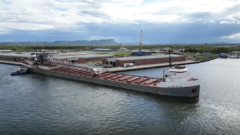
It’s been 50 years since a freighter sank in the Great Lakes. But in the summer of 2024, one freighter came dangerously close.
On June 8, 2024, the Michipicoten was carrying a load of iron ore across Lake Superior when the crew heard a loud bang. The ship was taking on water.
Great Lakes Now
https://www.greatlakesnow.org/2025/07/has-this-freighter-made-final-voyage/

By Emma McIntosh, The Narwhal
The Great Lakes News Collaborative includes Bridge Michigan, Circle of Blue, Great Lakes Now at Detroit PBS, Michigan Public and The Narwhal who work together to bring audiences news and information about the impact of climate change, pollution, and aging infrastructure on the Great Lakes and drinking water.
Great Lakes Now
https://www.greatlakesnow.org/2025/07/how-ontario-could-have-cracked-down-on-chemical-valley-pollution-but-chose-not-to/
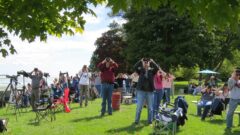
Great Lakes Moment is a monthly column written by Great Lakes Now Contributor John Hartig. Publishing the author’s views and assertions does not represent endorsement by Great Lakes Now or Detroit PBS.
What is one of the most frequently counted birds by citizen scientists in the annual Detroit River Hawk Watch, but is not a hawk?
Great Lakes Now
https://www.greatlakesnow.org/2025/07/great-lakes-moment-detroit-river-carrion-scavenger-on-the-increase/
The U.S. Environmental Protection Agency is providing $3.7 million in grants to four organizations to help farmers manage their nutrient applications in the watershed of Lake Erie’s Western Basin. Read the full story by The Plain Dealer.
Great Lakes Commission
https://www.glc.org/dailynews/20250707-lake-erie-funding
The water levels in the Great Lakes are continuing their seasonal rise into the summer months, with predictions for them to peak later in July or August. Read the full story by Erie Times-News.
Great Lakes Commission
https://www.glc.org/dailynews/20250707-lake-levels
The National Oceanic and Atmospheric Administration said in a bulletin issued Thursday that “patches” of cyanobacteria, commonly called blue-green algae, have been detected via satellite in western Lake Erie. Read the full story by the Toledo Blade.
Great Lakes Commission
https://www.glc.org/dailynews/20250707-lake-erie-bloom
The Biigtigong Nishnaabeg First Nation announced that it will contribute $1 million toward reestablishing Ontario’s Peninsula Harbour Port as a modern, functional transportation hub. Organizers have said the facility, to be constructed on the site Marathon Pulp’s former mill, will be the only commercial port between Thunder Bay and Sault Ste. Marie. Read the full story by Timmins Today.
Great Lakes Commission
https://www.glc.org/dailynews/20250707-marathon-port
Microcystin, the toxic chemical produced by Harmful Algal Blooms (HAB), has now been detected in the air as well as the water during HAB season. Researchers are collecting samples and investigating the effects of what this may mean for individuals spending time near Lake Erie during HAB season. Read the full story by the Toledo Blade.
Great Lakes Commission
https://www.glc.org/dailynews/20250707-hab-air
A barge that twice sank in Lake Michigan and sparked environmental concerns has now been moved to a legally authorized site. Read the full story by Huron Daily Tribune.
Great Lakes Commission
https://www.glc.org/dailynews/20250707-barge
For the first time in six years, the iconic light from the Two Harbors Lighthouse beacon 25 miles northeast of Duluth will once again sweep across Lake Superior. Read the full story by the Minnesota Public Radio.
Great Lakes Commission
https://www.glc.org/dailynews/20250707-duluth-lighthouse
The National Oceanic and Atmospheric Administration’s Office of National Marine Sanctuaries is hosting the “Get into Your Sanctuary” photo competition, with a new sanctuary to participate in this year after Lake Ontario National Marine Sanctuary was designated in 2024. Read the full story by CNY Central.
Great Lakes Commission
https://www.glc.org/dailynews/20250707-sanctuary-photos
Each year, Michigan’s Department of Natural Resources recruits teams of volunteer lighthouse keepers to staff the Tawas Point Lighthouse in two-week shifts. Read the full story by Michigan Public.
Great Lakes Commission
https://www.glc.org/dailynews/20250707-lighthouse-keeper
Current watches, warnings, and advisories for Brown County (WIC009) WI
Current watches, warnings, and advisories for Brown County (WIC009) WI
https://api.weather.gov/alerts/urn:oid:2.49.0.1.840.0.5c77d4ceb8b6289f7faa2d083f13512284ad1740.001.1.cap
Current watches, warnings, and advisories for Brown County (WIC009) WI
Current watches, warnings, and advisories for Brown County (WIC009) WI
https://api.weather.gov/alerts/urn:oid:2.49.0.1.840.0.77cbff583191acefb8a2c3afd8918e6db554ccb3.001.1.cap
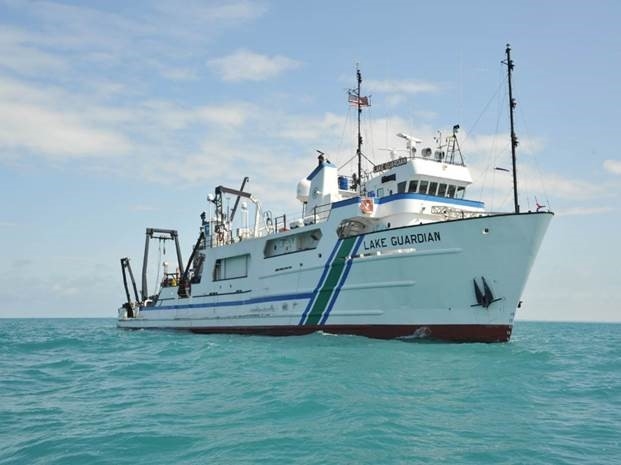
U.S. EPA’s research vessel Lake Guardian (EPA Photo).
Alina Prahl, Jamie Lauer, and Robert Fish will join Center for Great Lakes Literacy (CGLL) staff and Great Lakes scientists to work aboard the EPA research vessel Lake Guardian for a week and bring Great Lakes knowledge and information back to their classrooms. The expedition is July 7-13, 2025.
Alina Prahl is the program manager at Riveredge Nature Center in Saukville. She oversees all family and community educational programming at the center as well as teaches environmental education for school, summer, evening, and weekend groups.
“I’m extremely excited about the opportunity to travel around and get a better understanding of Lake Michigan and the Great Lakes, as well as explore the underwater archaeology and history of Lake Michigan,” said Prahl. “So much of what we will learn is pertinent to what we do here so I’m looking forward to incorporating that into our water programs at Riveredge.”
Jamie Lauer is a chemistry teacher at Hartford Union High School. She teaches Introductory Chemistry, AP Chemistry, and Forensic Science to 9-12 graders. After studying coral reef and urchin restoration in Puerto Rico, Jamie is looking forward to doing local research, especially in a chemistry lab aboard a moving ship.
“I’m also very excited about the maritime archaeology experience,” said Lauer. “The fact that this is the first kind of research being done in Lake Michigan is very interesting, and I can’t wait to share the experience with my students.”
Robert Fish is a Tribal Engagement Coordinator at UW-Green Bay. He works with tribal schools to develop, promote and integrate education programs around wetlands, estuaries, and coastlines, connecting those water science programs with Wisconsin First Nation history, culture, and sovereignty.
“I’m really looking forward to doing scientific research that can directly impact our understanding of the tribal history and presence in the Bay of Green Bay and also the Great Lakes in general,” said Fish. “With some of the lakebed mapping efforts happening through this project, we could find indigenous sites, which could bring what many consider ancient tribal history into a contemporary light.”
Through a partnership with the EPA Great Lakes National Program Office, NOAA, and with funding from the Great Lakes Restoration Initiative, educators will spend a full week alongside researchers aboard the Guardian. Hosts for the Lake Michigan expedition are CGLL partners Illinois-Indiana Sea Grant and Wisconsin Sea Grant.
The Shipboard Science Immersions are designed to promote Great Lakes sciences while forging lasting relationships between Great Lakes researchers and educators. CGLL is a collaborative effort led by Sea Grant educators throughout the U.S. Great Lakes watershed. CGLL fosters informed and responsible decisions that advance basin-wide stewardship by providing hands-on experiences, educational resources, and networking opportunities promoting Great Lakes literacy among an engaged community of educators, scientists, and youth.
For more information on the 2025 Shipboard Science Immersions visit the Center for Great Lakes Literacy website.
# # #
The University of Wisconsin Aquatic Sciences Center administers Wisconsin Sea Grant, the Wisconsin Water Resources Institute, and Water@UW. The center supports multidisciplinary research, education, and outreach for the protection and sustainable use of Wisconsin’s water resources. Wisconsin Sea Grant is one of 34 Sea Grant programs supported by the National Oceanic and Atmospheric Administration in coastal and Great Lakes states that encourage the wise stewardship of marine resources through research, education, outreach, and technology transfer.
The post Shipboard Science Immersion on Lake Michigan first appeared on Wisconsin Sea Grant.
News Releases | Wisconsin Sea Grant
News Releases | Wisconsin Sea Grant
https://www.seagrant.wisc.edu/news/shipboard-science-immersion-on-lake-michigan/
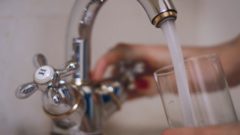
By Katie Thoresen, WXPR
This story was originally published by WXPR. WXPR is a community-licensed public radio station serving north central Wisconsin and adjacent areas of Michigan’s Upper Peninsula. Listen to their stories here.
People on private wells in five Oneida County Townships in Wisconsin may be offered free PFAS testing.
Great Lakes Now
https://www.greatlakesnow.org/2025/07/wisconsin-dnr-expands-private-well-pfas-testing-five-oneida-county-townships/
The U.S. Supreme Court announced Monday it will review whether Michigan Attorney General Dana Nessel’s lawsuit seeking to shut down a section of Enbridge’s Line 5 pipeline beneath a Great Lakes channel belongs in state or federal court. Read the full story by the Associated Press.
Great Lakes Commission
https://www.glc.org/dailynews/20250702-line-5
The Detroit River Canadian Cleanup has released its annual report for 2024-25 outlining restoration milestones for the Detroit River, successfully restoring 11 of the 14 beneficial use impairments with expected removal of the Detroit River from the areas of concern list by 2028-29. Read the full story by CKLW – Windsor, ON.
Great Lakes Commission
https://www.glc.org/dailynews/20250702-detroit-river-aoc
Chicago has more lead service lines than other cities in the country, and replacements are not planned to be complete until 2076. Read the full story by Great Lakes Now.
Great Lakes Commission
https://www.glc.org/dailynews/20250702-chicago-lead-pipes
The Ohio Legislature’s attempt to hobble H2Ohio through steep budget cuts is mystifying many given the results have demonstrated noticeable reductions in runoff. Read the full story by The Plain Dealer.
Great Lakes Commission
https://www.glc.org/dailynews/20250702-h2ohio
After nearly four decades and $80 million of cleanup efforts, Muskegon Lake in Michigan is finally on track to being delisted as a Great Lakes Area of Concern after restoration activities concluded in 2022. Read the full story by MLive.
Great Lakes Commission
https://www.glc.org/dailynews/20250702-muskegon-lake
Representative Bill Huizenga of Michigan is calling on the U.S. Senate to reinclude funding for a new Great Lakes heavy icebreaker in its reconciliation bill after the provision was left out of the Senate version of the One Big Beautiful Bill Act. Read the full story by WorkBoat.
Great Lakes Commission
https://www.glc.org/dailynews/20250702-icebreaker-cuts
An environmental group is suing to stop construction on the expansion of a tailings basin holding back mine waste near Lake Superior. Read the full story by Duluth News Tribune.
Great Lakes Commission
https://www.glc.org/dailynews/20250702-tailings-basin-lawsuit
A group that represents a cross-section of business and environmental interests said in a news release it is “deeply concerned and disappointed” by a proposed $105 million cut to H2Ohio’s budget. Read the full story by The Toledo Blade.
Great Lakes Commission
https://www.glc.org/dailynews/20250702-eriefoundation-h2ohio
The Sauble Beach sign was changed to reflect a court decision last year that solidified ownership of a roughly two-kilometer section of land along the Lake Huron shoreline to the Chippewas of Saugeen First Nation. The sign now reads “now reads “Welcome to Saugeen Beach.” Read the full story by CBC News.
Great Lakes Commission
https://www.glc.org/dailynews/20250702-sauble-beach
Gabby, the oldest Great Lakes piping plover, had two new chicks at Sleeping Bear National Lakeshore. Read the full story by MLive.
Great Lakes Commission
https://www.glc.org/dailynews/20250702-piping-plover

“Nibi Chronicles,” a monthly Great Lakes Now feature, is written by Staci Lola Drouillard. A Grand Portage Ojibwe direct descendant, she lives in Grand Marais on Minnesota’s North Shore of Lake Superior. Her nonfiction books “Walking the Old Road: A People’s History of Chippewa City and the Grand Marais Anishinaabe” and “Seven Aunts” were published 2019 and 2022, and the children’s story “A Family Tree” in 2024.
Great Lakes Now
https://www.greatlakesnow.org/2025/07/where-the-strawberries-still-grow/
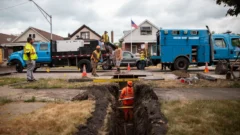
By Keerti Gopal & Juanpablo Ramirez-Franco
This story is a partnership between Grist, Inside Climate News, and WBEZ, a public radio station serving the Chicago metropolitan region. This coverage is made possible through an ongoing partnership between Grist and WBEZ.
Great Lakes Now
https://www.greatlakesnow.org/2025/07/chicago-residents-risk-daily-lead-exposure-from-toxic-pipes-replacing-them-will-take-decades/
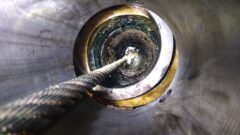
By Emilio Perez Ibarguen, Bridge Michigan
The Great Lakes News Collaborative includes Bridge Michigan; Circle of Blue; Great Lakes Now at Detroit PBS; Michigan Public, Michigan’s NPR News Leader; and The Narwhal who work together to bring audiences news and information about the impact of climate change, pollution, and aging infrastructure on the Great Lakes and drinking water.
Great Lakes Now
https://www.greatlakesnow.org/2025/07/great-lakes-scientists-discover-new-lifeform-microbe-name-it-shipgoo1/
Goby Reported By Angler near Bowen Street Fishing Pier in Oshkosh We need your help! We ask anglers to be on the lookout for any round gobies (Neogobius melanostomus) in the Winnebago System and to report any catches or sightings of these invasive fish. Round gobies are an aggressive invasive fish that reproduces quickly and [...]
The post Reminder – Report Catches of Round Goby in Winnebago System appeared first on Fox-Wolf Watershed Alliance.
Fox-Wolf Watershed Alliance
https://fwwa.org/2025/07/01/reminder-report-catches-of-round-goby-in-winnebago-system/?utm_source=rss&utm_medium=rss&utm_campaign=reminder-report-catches-of-round-goby-in-winnebago-system
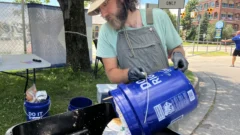
By Izzy Ross, Interlochen Public Radio
This coverage is made possible through a partnership between Interlochen Public Radio and Grist, a nonprofit environmental media organization.
Lucas Roff met his then-girlfriend when he was going to college at Lake Superior State University in Sault Ste.
Great Lakes Now
https://www.greatlakesnow.org/2025/06/after-trump-cuts-michigan-helps-pay-for-remainder-of-climate-work-program/
Great Lakes Landing Blitz, June 30 – July 13 Original Story: WI DNR Help stop the spread of aquatic invasive plants and animals this July 4th weekend as part of the Great Lakes Landing Blitz, June 30th - July 13th, 2025. Thousands of boaters and anglers will be out enjoying Wisconsin’s waters during the Independence [...]
The post Great Lakes Landing Blitz: Help Stop The Spread Of Aquatic Invasive Species appeared first on Fox-Wolf Watershed Alliance.
Fox-Wolf Watershed Alliance
https://fwwa.org/2025/06/30/great-lakes-landing-blitz-help-stop-the-spread-of-aquatic-invasive-species/?utm_source=rss&utm_medium=rss&utm_campaign=great-lakes-landing-blitz-help-stop-the-spread-of-aquatic-invasive-species
If Lake Winnebago is your happy place, here’s a simple way to give back without giving up your weekend. We’re looking for a boat-owning volunteer to help monitor water quality near Fond du Lac. It’s just one short trip a month through early fall. We’ll provide the gear and the training. You bring the [...]
The post Got a Boat? Put It to Work for Clean Water appeared first on Fox-Wolf Watershed Alliance.
Fox-Wolf Watershed Alliance
https://fwwa.org/2025/06/30/boat-monitor/?utm_source=rss&utm_medium=rss&utm_campaign=boat-monitor
The waters of Lake Winnebago, Wisconsin’s largest inland lake, were once teeming with wild rice – so abundant that historical accounts describe boats struggling to pass through the beds.
This native aquatic plant, known as “mayom” in the Mohegan language and “manoomin” in the Ojibwe language, has deep cultural and ecological significance, supporting fish, waterfowl, and overall ecosystem health.
Over the last 200 plus years, increased populations, shoreline development, and dams have stripped much of Lake Winnebago of this treasured resource. But through research initially funded by Wisconsin Sea Grant, the Lake Winnebago Wild Rice Revitalization team aims to restore wild rice beds, bringing together tribal nations, researchers, and conservationists in a project that bridges history, science, and community collaboration.
The Lake Winnebago Wild Rice Revitalization Project is a multi-year effort focused on reestablishing wild rice beds to harvestable levels. Co-led by the Brothertown Indian Nation and UW-Madison’s Dr. Jessie Conaway, the team seeks to answer critical questions: Where did the rice go? What conditions are needed to bring it back? And how can restoration efforts honor both traditional ecological knowledge and modern science?
For members of the Brothertown Indian Nation, whose ancestors were relocated to the eastern shores of Lake Winnebago in the 1800s, this work is deeply personal. “These waters are our responsibility,” says Vice Chair of the Brothertown Indian Nation Jessica Skeesuck, one of the project leaders. The restoration effort is not just about bringing back a plant – it’s about strengthening tribal nations, supporting wildlife, and fostering a healthier watershed for all fishers, hunters, harvesters, and Lake Winnebago communities.
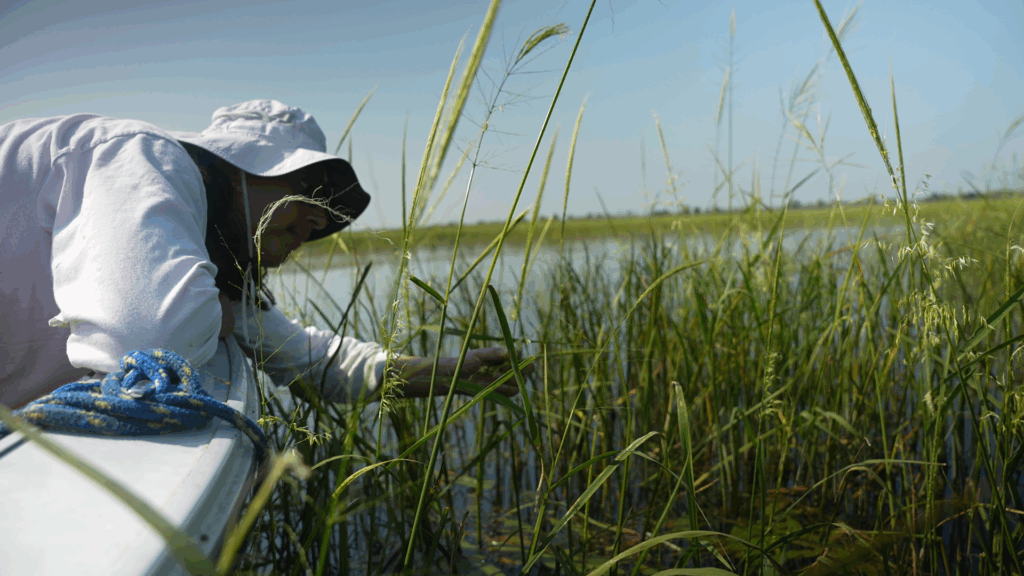
Alex Mixtli, Environmental Specialist, surveys wild rice from a boat on Pawāhan-Sīpiah (Pine River), which means “wild rice gathering river” in the Menominee language. By studying water depth, sediment, and competition from other plants, researchers are learning where and why wild rice thrives.
Since receiving funding from Wisconsin Sea Grant in 2022, the team has had a number of successes. University students and agency partners have helped gather water quality data and monitor plant growth, creating a new baseline of wild rice data in the Lake Winnebago watershed. This data, as well as Indigenous knowledge, has helped the team begin reseeding portions of the watershed.
Community engagement has also grown, with more volunteers, tribal members, and local residents actively participating in restoration efforts. For the Brothertown Indian Nation, this work has been an opportunity for nation-building, strengthening connections to tribal conservation networks and providing the small nation with their first full-time staff members.
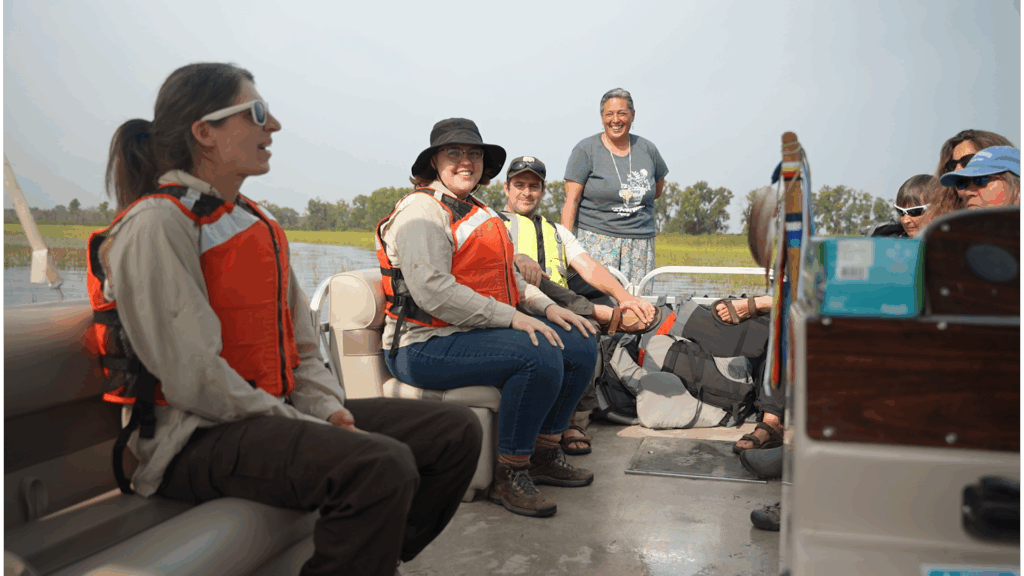
The project team has assembled a wide-ranging partnership with groups such as the WI DNR, US Fish and Wildlife Service, the Wisconsin Tribal Conservation Advisory Council and more. They gather for an annual on-water meeting every summer, where they share updates and often reseed rice by hand.
The project is also supported by the US Fish and Wildlife Service Natural Resources Damage and Assessment Program, the Daybreak Fund, and the Fund for Lake Michigan.
“It’s pretty powerful to be at this place in the journey where we found some rice and we know what’s going good with it. We’re learning how to help it do better and we’ve continued to build really good relationships with our partners, both tribal and non-tribal,” says Skeesuck. “When we look out and see more rice here than there was last year – that just gives me so much hope.”
To learn more about the Lake Winnebago Wild Rice Revitalization Project and their innovative weaving of western science and Indigenous knowledge, watch our video here.
The post New video captures wild rice revival project in Lake Winnebago first appeared on Wisconsin Sea Grant.News Releases | Wisconsin Sea Grant
News Releases | Wisconsin Sea Grant
https://www.seagrant.wisc.edu/news/new-video-captures-wild-rice-revival-project-in-lake-winnebago/
Artificial intelligence data centers consume massive amounts of water for cooling servers and generating electricity. It is currently unknown exactly how much water these centers are already withdrawing from the Great Lakes and what future withdrawals will be. Read the full story by Cleveland Magazine.
Great Lakes Commission
https://www.glc.org/dailynews/20250630-ai-water-use